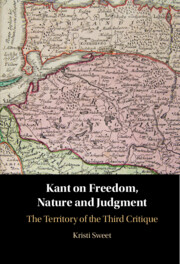Book contents
- Kant on Freedom, Nature, and Judgment
- Kant on Freedom, Nature, and Judgment
- Copyright page
- Dedication
- Epigraph
- Contents
- Acknowledgments
- Abbreviations
- Introduction
- 1 Reason, Hope, and Territory
- 2 Reflection, Purposiveness, Metaphysics
- 3 “Life” and the Ideal of Beauty
- 4 The Sensus Communis and the Ground of the Critical System
- 5 Genius, Aesthetic Ideas, and a Spiritualized Natural Order
- 6 The Domain of Nature as System: Ends
- 7 Hope and Faith: God in the Critique of Teleological Judgment
- Conclusion
- Bibliography
- Index
3 - “Life” and the Ideal of Beauty
Published online by Cambridge University Press: 07 August 2023
- Kant on Freedom, Nature, and Judgment
- Kant on Freedom, Nature, and Judgment
- Copyright page
- Dedication
- Epigraph
- Contents
- Acknowledgments
- Abbreviations
- Introduction
- 1 Reason, Hope, and Territory
- 2 Reflection, Purposiveness, Metaphysics
- 3 “Life” and the Ideal of Beauty
- 4 The Sensus Communis and the Ground of the Critical System
- 5 Genius, Aesthetic Ideas, and a Spiritualized Natural Order
- 6 The Domain of Nature as System: Ends
- 7 Hope and Faith: God in the Critique of Teleological Judgment
- Conclusion
- Bibliography
- Index
Summary
Chapter 3 examines Kant’s account of the Ideal of Beauty. Contrary to most interpretations, it takes Kant at his word that the Ideal forms the measure of the judgment of taste in providing the original pattern that all other beautiful things follow. It further argues that the content of what Kant describes in the Ideal is nothing other than life. Life, for Kant, is the unthinkable causal union between force and matter, freedom and nature. All judgments of taste, then, refer us to such a unity, and thus to an outside of the critical system. Nevertheless, in suggesting the possibility of such a union, the beautiful is able to serve as a transition and likely ground of the two domains of freedom and nature.
- Type
- Chapter
- Information
- Kant on Freedom, Nature, and JudgmentThe Territory of the Third <i>Critique</i>, pp. 81 - 103Publisher: Cambridge University PressPrint publication year: 2023

